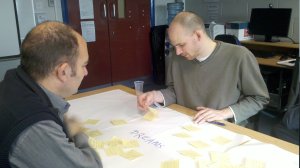Last week Ale and I had a very productive meeting with our colleague at the University of Derby, Phill, to reflect on the achievements of the OSTRICH project so far, and the lessons learnt and questions that have arisen out of the project. Losing Linda Swanson has obviously been a major setback and very distressing for all of us, but despite the difficulties and everyone’s sadness around this situation, we all agreed that the project was running as smoothly as it could be under the circumstances.
One of the “lessons learnt” about the cascade process that I found particularly interesting was that there seems to be no getting away from the fact that our face-to-face meetings have been more fruitful (and more enjoyable) than online meetings. Online meetings are good enough for simple updates and joint decision-making on relatively straightforward issues, but when we wanted to do some deep collaborative thinking (e.g. in drawing up our revised model of CORRE that we shared at OER11) or to reflect in a relaxed way on the project (as in the meeting at Derby last week), everyone was firmly of the opinion that a face-to-face meeting would be more productive.
Perhaps one day we will have webconferencing technology that more closely emulates the nuances of face-to-face communication than is possible today. In the meantime, I think that in any future projects of this nature, we will build regular face-to-face visits into the schedule from the start if possible.
Gabi Witthaus, 7 June 2011
